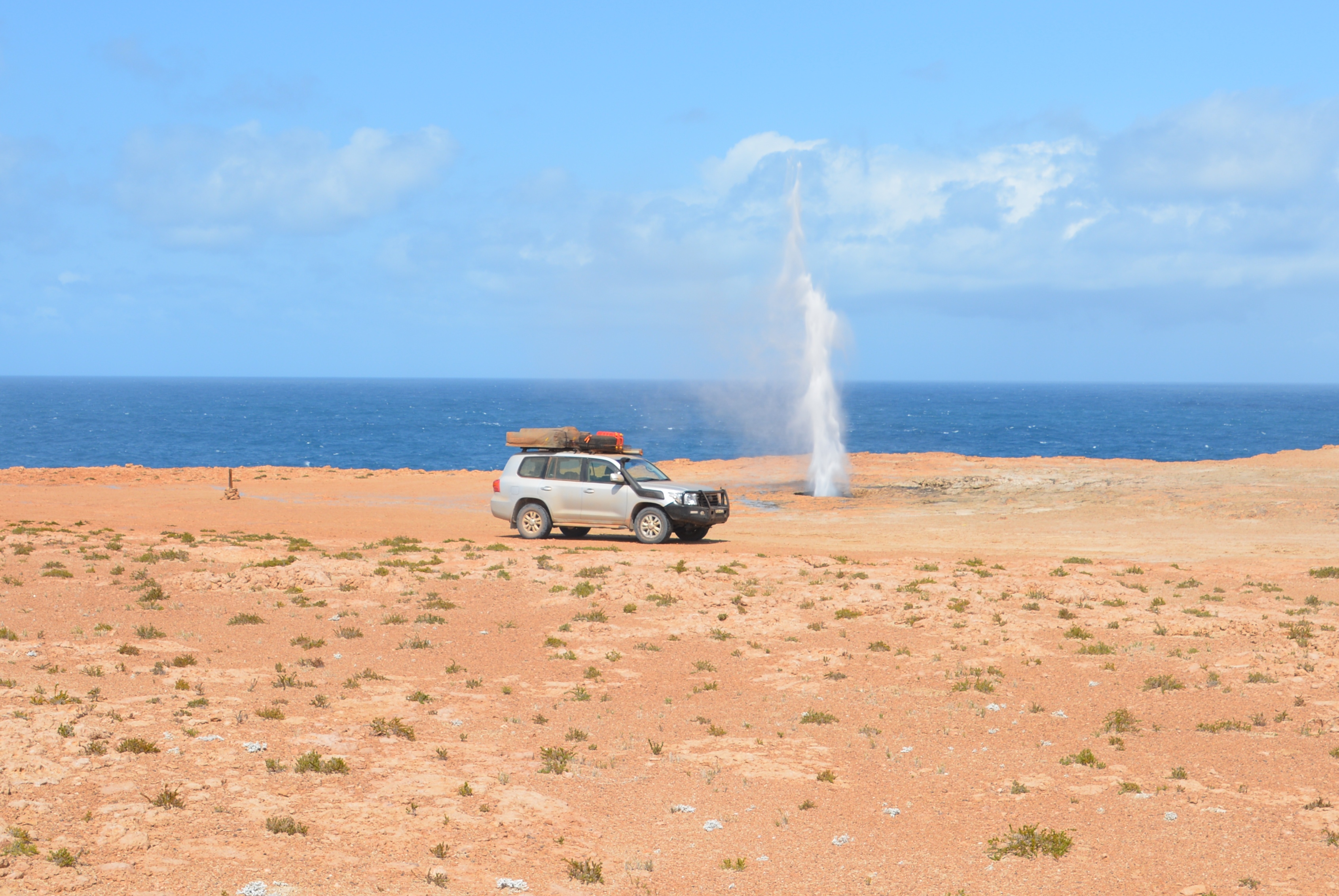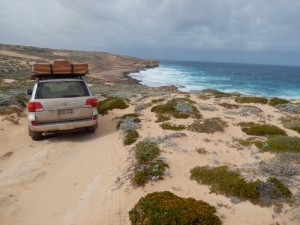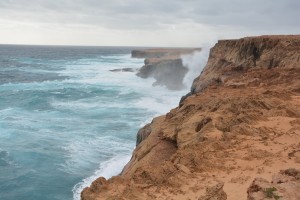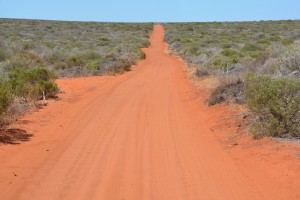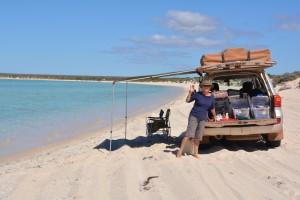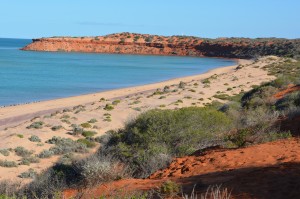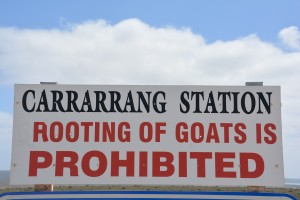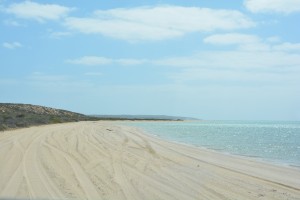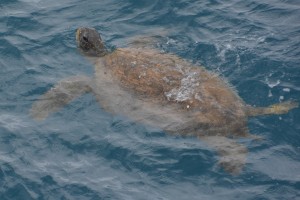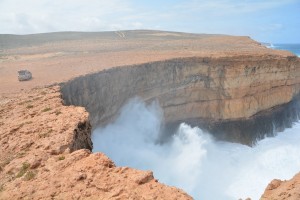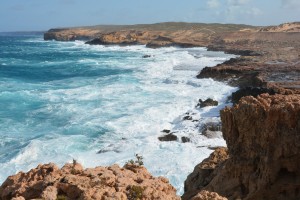Monkeys, dolphins, sharks and wind
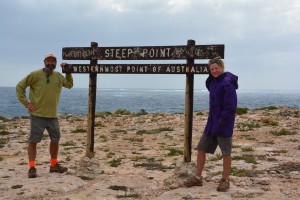
Triumphantly standing at the western most point of mainland Australia - and what a journey to get there!
What sort of a name is Monkey Mia for a place that is famous for feeding dolphins? And if it’s so well known for dolphins why is the water called Shark Bay? Did a European really set foot here 150 years before Captain Cook? Why is Steep Point so geographically important? And what the heck is stromatolite? Finally, why is the entire peninsula a UNESCO World Heritage listed place? These important questions needed answers and it was our duty to find them.
In fact, it all became clear to us, except for the Monkey name, as we spent a few fabulous days exploring this wonderful corner of Australia. The beaches, wild barren landscape, stunning cliff shoreline, astounding sand dunes, great wildlife, multiple national parks and bizarre ancient creatures gave this peninsula a broad and fascinating appeal that we didn’t expect and were totally overwhelmed by. What a place!
The Shark Bay area is quite unique in that it has two major peninsulas that run parallel and point northward into the Indian Ocean. The result of this is numerous bays, some quite shallow and protected, while the ferocious Indian Ocean crashes against the high cliffs of the western shoreline. All of these unique features combine to create a fascinating playground for adventurous travellers.
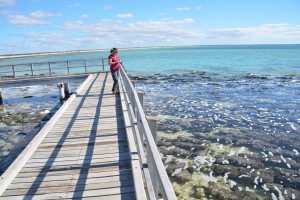
Julie looks down on an amazing bed of stromatolites that have been there for thousands of millions of years
One part of the inner bay is called Hammelin Pool which is one of the few remaining homes on earth for stromatolites. Stromatolites are one of earth’s original microbes that helped create oxygen for all future plants and animals over 3000 million years ago. In one of the few places in the world where these ancient life form still exists we were able to walk along a boardwalk and look down on them, learning more about their ancient science. Another fascinating piece of information we really didn’t know before.
We camped that night on the shore of an inland waterway flanked by a high cliff, walked amongst the coastal sand banks where various birds and fish went about their business and watched a beautiful sunset. The Ranger who busted us the next morning only charged us $10 for the privilege. It was worth far more.
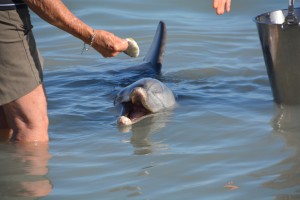
Tourists feeding 'wild' dolphins at Monkey Mia, surprisingly good fun if you leave your cynicism behind
We drove out to the end of the paved road to Monkey Mia, despite our heightened expectations about dolphins and sharks it was really only a modest tourist resort and jetty with a picturesque calm shallow bay. We followed a hundred other people down to the shoreline at 8am to watch the dolphins slowly swim into shore, knowing that fish and photos awaited them. We waded in up to our knees and enjoyed a very touristy but surprisingly fun experience of having dolphins swim up to us and be fed by randomly selected visitors. As we had coffee in the coffee shop afterwards an emu casually wandered through the grounds looking for breakfast as well. Apparently perfectly normal in Monkey Mia.
After a quick visit to the sleepy little touristy town of Denham we headed north into Francois Peron National Park. We’ve been analysing some of the names of the parks around Australia and much prefer names referring to local features (such as Mitchell Falls or Tunnel Creek) or even better, local aboriginal names (such as Purnululu or Nitimuluk). But naming a park after some old European botanist seems like a stretch. But Francois Peron it is and off we went after lowering our tyre pressure and heading off into the little visited northern tip of the peninsula.
The western coastline is marked by high red cliffs and waves that have enjoyed thousands of kilometres of unhindered momentum before crashing into the battered shoreline. We took every offshoot track we could, loving the drive on soft sandy tracks, exploring each beach or cliff line that we could reach. At Herald Bight, on the eastern side, the sand was desperately deep but we were able to drive along the beach and enjoy lunch and a great swim in the shallow sandy water. If it hadn’t been for the relentless swarm of killer midgies that attacked from all directions we would have stayed a week.
At the tip of the peninsula, Cape Peron, we walked along the cliff for a couple of kilometres to Skipjack Point and from this high vantage point saw sharks swimming in the shallows and sharing the water with graceful eagle rays and thousands of black and white cormorants on the beach down below. This walk alone made the whole trip up the peninsula worthwhile and we camped that night at Bottle Bay, a quiet little spot with total solitude except for the wind which blew hard all night and erased all our footprints in the sand by morning.
The next morning we drove back down the peninsula and after some consideration decided to drive up the wild and narrow western peninsula on a road intriguingly called Useless Loop. The main attraction of following this sandy track 150 kilometres is that it finished at Steep Point, the western most point of mainland Australia. We had to get there.
This turned out to be a journey for the ages, one of the most fun – and challenging – four wheel drive tracks we have ever done. The last half of the track was narrow and over very soft sands, sometimes skirting or even crossing sand dunes that stretched as far as one could see. The Land Cruiser again proved how powerful it was, climbing over steep sand dunes with desperately soft sand, its V8 turbo diesel engine powering over all obstacles. The rolling sand dunes, low lying spinifex and wind-swept heath scrub that clung to life on the dunes and the roar of the nearby ocean made this an absolutely spectacular drive.
Finally we made it to Steep Point, the western most point in mainland Australia, giving us the rare – and totally irrelevant – claim of having visited the four furthest points of the compass in Australia. We watched fishermen fish off the nearby cliffs, saw a huge green turtle in the water below while one guy pulled in a beautiful trevally, great stuff. We finished the day by doing a drive along the track that hugged the cliff and watched the huge waves crash into the rock walls, sometimes throwing the sea up to 100 metres high. The power and the fury of the angry ocean was spellbinding stuff from our high vantage point.
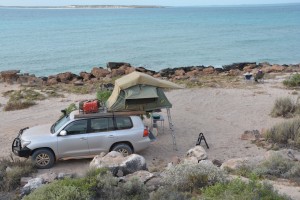
Our campsite at Steep Point - a cold and miserable place and absolutely spectacular all at the same time
That night we camped in a barely sheltered site on the shore opposite Dirk Hartog Island, named after the Dutch sailor who landed there in 1616, the first confirmed European to walk on Australian shore (and 150 years before Captain Cook!). This was another cold windy night in one of the most obscure and remote corners of Australia, no fire, very little shelter from the strong winds, even a bit of rain to round it out. It was hard going but we wouldn’t have given up the experience of Steep Point for anything.
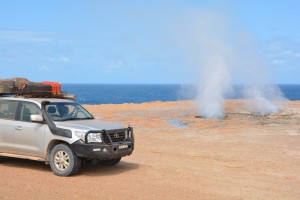
Amazingly we could drive right up to the blow holes at False Entrance - the Cruiser loves posing for these photos
The next day we explored other parts of the peninsula, including two well named places called Thunder Bay and False Entrance. But to get to both of these places it involved long fun drives over and around the sand dunes, some with a cover of grasses and scrubby heath, all requiring some courage and luck. Each of these places featured blow holes where there were holes in the rock near the cliff and the crashing waves would thunderously force themselves up the chute and blow out of the hole, sometimes 30 or 40 metres in the air. We were able to park the Cruiser next to some of these holes, such was the lack of barriers or even defined tracks, and enjoy the full fury of the ocean from a unique perspective. Blow holes are very cool.
Our experience on the Useless Loop road, visiting Steep Point, the amazing cliff-lined coast and the sand dunes was absolutely one of the highlights of the 82 days we had been on the road so far. And to think we almost made the decision not to do it is a lesson in itself. Honestly, everyone should make a point of seeing this place for the adventure, for the stunning scenery, for the challenging drive and as a bonus for being able to say you stood at the western most point. It’s rugged, the weather is very dodgy and there are no creature comforts anywhere nearby. But to think that only a handful of hearty local fishermen and intrepid four wheel drivers ever make it is a great shame.
